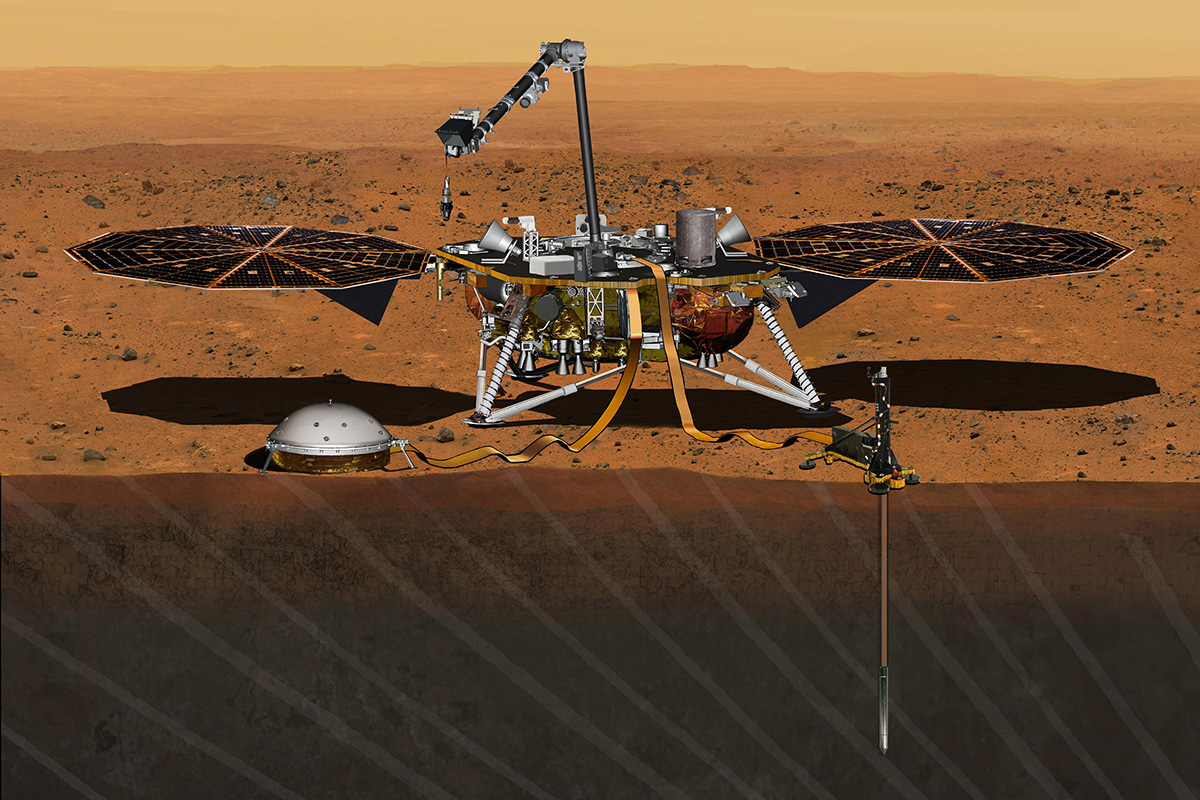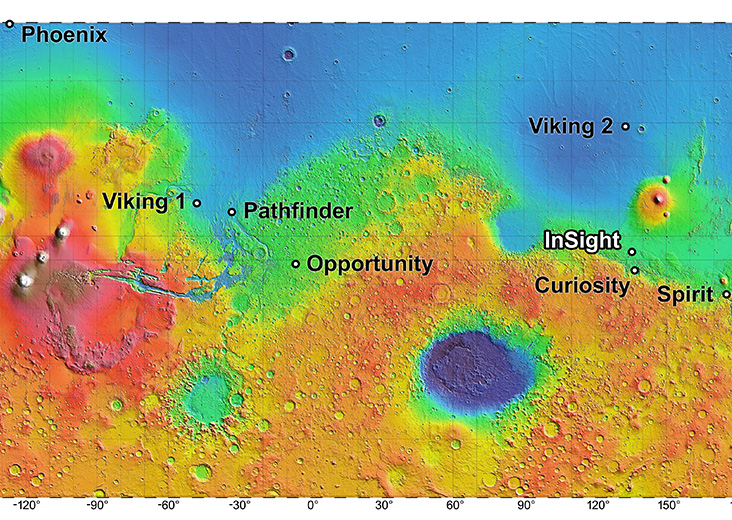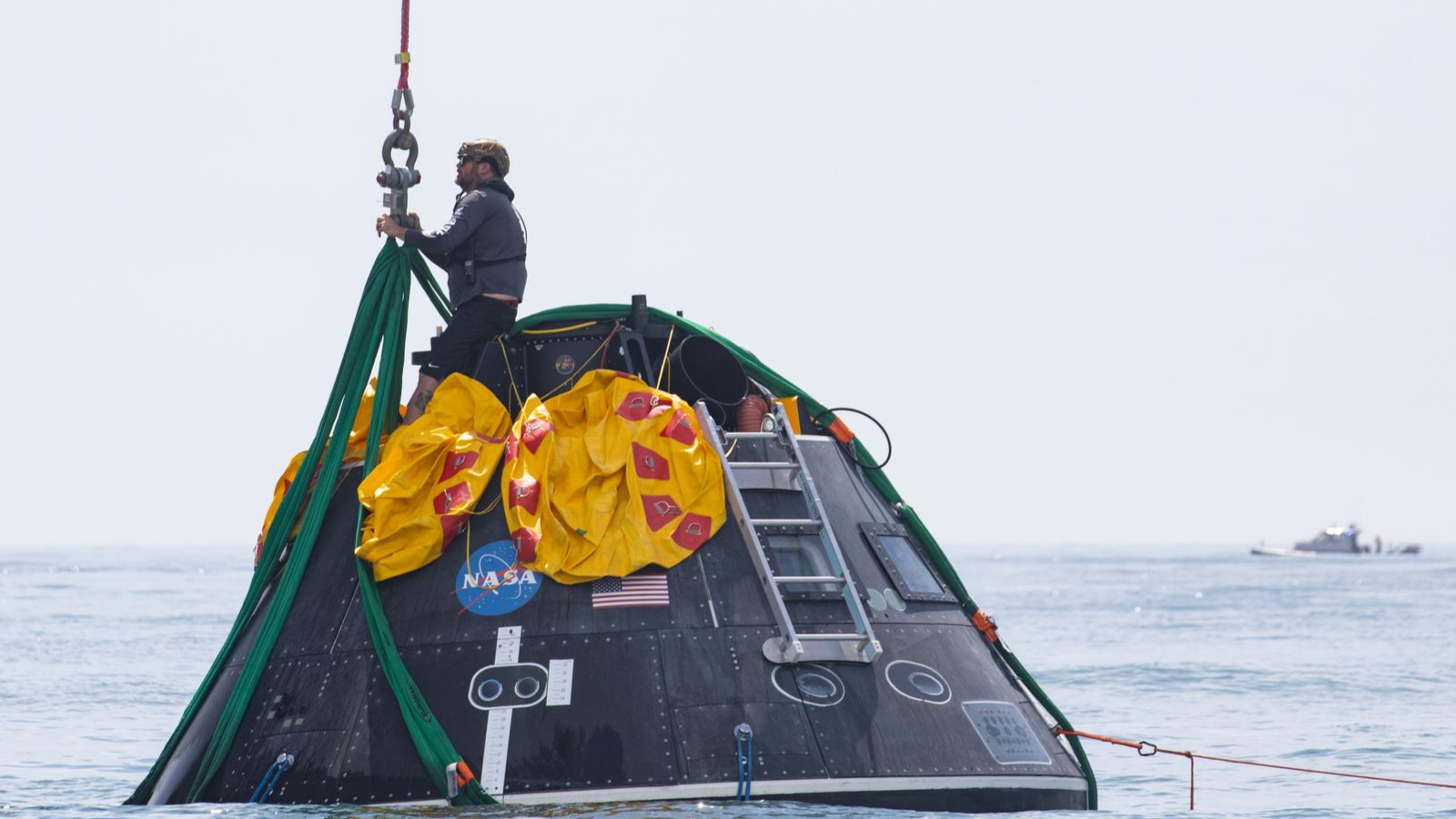InSight Lander: Probing the Martian interior
NASA's InSight Mars lander is a stationary probe designed to study the interior of the Red Planet. Its permanent position — unlike NASA's Perseverance, Opportunity, Spirit and Curiosity rovers that roll across the surface of Mars — is necessary for its major science goals, which include learning more about the Martian composition and how tectonically active Mars is. The mission was also notable for its CubeSats, which were the first such tiny spacecraft fly beyond Earth before they fell silent in 2019.
InSight launched toward Mars on May 5, 2018, from Vandenberg Air Force Base in California, on an Atlas V vehicle from United Launch Alliance. The mission landed successfully on Nov. 26, 2018 at the Martian Elysium Planitia, an equatorial zone just south of an ancient volcanic area. InSight was originally slated to send back data about the Red Planet's interior for about 1 Mars year, or 728 Earth-days (a little more than two Earth years), but NASA has extended the mission through December 2022.
Related: You can see launch photos here.
In its first year on Mars, InSight returned information on earthquakes on Mars (marsquakes), some possible models for the core of the planet and the tiny wobbles in the planet's orbit. Unexpectedly hard soil or regolith, however, prevented the lander's mole-like robot attachment from drilling its way under the surface, and that project was abandoned.

InSight is short for a rather lengthy name: Interior Exploration using Seismic Investigations, Geodesy and Heat Transport. The mission has a total cost of $814 million, NASA officials have said.
How InSight was built
InSight was one of 28 submissions for NASA's next Discovery-class mission in 2010. This type of mission is a lower-cost explorer of the solar system. During InSight's selection round, individual proposals weren't allowed to exceed $425 million, excluding the cost of the launch vehicle.
InSight – then known as the Geophysical Monitoring Station (GEMS) – and two other finalists (Titan Mare Explorer and Comet Hopper) each received $3 million in May 2011 to perform a concept study. InSight was tapped in August 2012 for the next launch. Construction began on InSight in May 2014. Its manufacturer is Lockheed Martin Space Systems.
NASA's InSight Mars Lander: 10 Surprising Facts
In December 2015, NASA announced it could not launch as planned in March 2016 because of a leak in one of the craft's instruments, the Seismic Experiment for Interior Structure (SEIS). At the time, agency officials said the mission might be removed entirely from the launch manifest. One limitation the agency cited was concern about exceeding the $675 million cost of the mission that included launch, data analyses and scientific operations. (At the time, they had spent $525 million.)
By the following fall, in September 2016, NASA announced a revised launch date for InSight. The announced delay to spring 2018 was no large surprise to the community, because the orbits of Mars and Earth only align favorably for a spacecraft flight every 26 months; outside of that window, it takes too much fuel to easily get to the Red Planet.
"The instrument redesign and two-year delay add $153.8 million" to the $675 million mission cost, NASA said in a statement. "The additional cost will not delay or cancel any current missions, though there may be fewer opportunities for new missions in future years, from fiscal years 2017-2020," it added.

InSight lander's scientific goals
InSight has two major science goals, according to NASA. The first is to examine the interior of Mars — what it is made of, and what processes occur below the surface. The lander will provide information on the size and composition of the Martian core, crust and mantle. It also will show "how warm the interior is and how much heat is still flowing through," NASA said.
The second goal is to learn if Mars is tectonically active (including where seismic activity is located), and how frequently meteorites slam into its surface.
InSight in Pictures: NASA's Mission to Probe Mars's Core
"Previous missions to the Red Planet have investigated its surface by studying its canyons, volcanoes, rocks and soil. But the signatures of the planet's formation can only be found by sensing and studying its vital signs far below the surface," NASA said.
InSight's instruments
InSight has three instruments that are designed to look at the deep interior of Mars and learn about the planet's geological activity, warmth and elements of its evolution, according to NASA.
The Seismic Experiment for Interior Structure (SEIS) detects seismic waves from meteorite impacts, magma movements inside the planet, or marsquakes.
The Heat Flow and Physical Properties Probe, or HP3, will burrow about 5 meters (16 feet) into the surface. It's often referred to as a "mole." Its main job was to sense heat underground, although it was unable to dig below the surface and work with the mole was discontinued as of Jan. 14, 2021.
The Rotation and Interior Structure Experiment, or RISE, provides information about the composition of the Martian core. It will keep careful track of where the lander is located, and from that information, discern any wobbles in the orbit of Mars as the planet orbits the sun. The composition of the core will influence the degree and type of oscillation Mars experiences.
InSight also has a robotic arm that is more than 7 feet (2.4 m) long. This arm placed the seismometer and heat-flow probe on the surface for their measurements, and gave the heat-measuring mole probe a nudge when the mole could not dig below the surface. The arm also features a camera that will take "color 3D views of the landing site, instrument placement, and activities," according to NASA. In addition, InSight has sensors to provide information on the weather, and any changes in the local magnetic field nearby the lander.
Riding along with InSight were the first cubesats to fly beyond Earth. The experiment, which encompasses two spacecraft, is called Mars Cube One. The cubesats flew behind InSight during its journey to Mars. NASA named the cubesats "Wall-E" and "Eva" because they used fire extinguisher fluid as thruster propellant, just like the animated robot in Disney's "Wall-E" movie.
The cubesats were nearly lost, but successfully witnessed and sent information back to Earth about the spacecraft's last few minutes flying to the Red Planet's surface.
Additional resources
- See NASA's InSight Mission page
- Read more on the humming InSight has reported in National Geographic
- Follow the mission on Twitter
This article was updated on Mar. 22, 2021 by Space.com Reference Editor Vicky Stein.
Join our Space Forums to keep talking space on the latest missions, night sky and more! And if you have a news tip, correction or comment, let us know at: community@space.com.
Breaking space news, the latest updates on rocket launches, skywatching events and more!

Elizabeth Howell (she/her), Ph.D., was a staff writer in the spaceflight channel between 2022 and 2024 specializing in Canadian space news. She was contributing writer for Space.com for 10 years from 2012 to 2024. Elizabeth's reporting includes multiple exclusives with the White House, leading world coverage about a lost-and-found space tomato on the International Space Station, witnessing five human spaceflight launches on two continents, flying parabolic, working inside a spacesuit, and participating in a simulated Mars mission. Her latest book, "Why Am I Taller?" (ECW Press, 2022) is co-written with astronaut Dave Williams.
